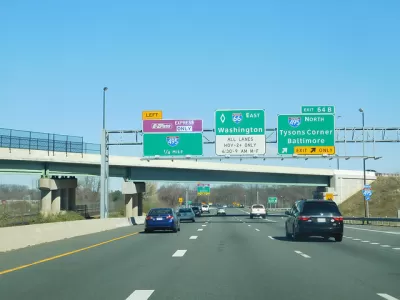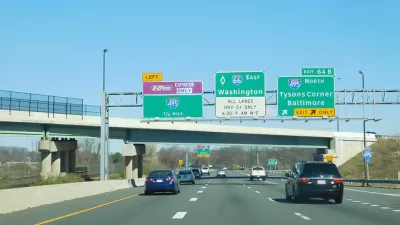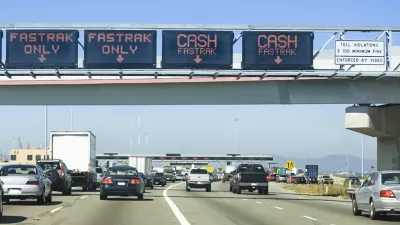When tolls rise on the 66 Express Lanes, trips decrease. according to a new report by the Virginia Department of Transportation.

A new report from the Virginia Department of Transportation comparing the third quarter of 2019 to 2018 on the 66 Express Lanes shows that the average roundtrip toll increased by about 6% while the average number of daily trips decreased 4% to 9%, depending on direction.
Note that the toll fee didn't increase, because these express lanes lack the toll schedule or toll rate table typically associated with the nation's tolled road and bridge facilities, such as those found in the International Bridge, Tunnel and Turnpike Association's 4-page reference, "Links to Toll Rate Pages - 2017" [pdf].
In addition, the 66 Express Lanes Inside the Beltway sets no "cap" or upper limit on tolls; the dynamically-priced tolls increase and decrease with the level of congestion, changing every six-minutes so as to maintain a minimum 45 mph speed, a federal requirement for both High Occupancy Vehicle (HOV) and High Occupancy Toll (HOT) lanes.
The Virginia Department of Transportation, or VDOT, reported on the average tolls paid by drivers for three months last year: July, August, and September, and compared them with the same months in 2018. Their 6-page "Performance Report for the Third Quarter 2019 Report [pdf]" has lots of other data, including the number of trips, speed of trips, travel times, how tolls were paid, and carpooling trips. However, the data applies only to trips taken during peak hours when tolling applies:
- Eastbound: 5:30 – 9:30 a.m.
- Westbound: 3:00 – 7 p.m.
The express lanes on Interstate 66 go nine miles [png] from just north of Falls Church in the west through Fairfax and Arlington counties to Rosslyn, near the Theodore Roosevelt Bridge crossing of the Potomac River to the District of Columbia.
"During the morning tolling hours on eastbound I-66, trips decreased from 15,097 to 13,707, or 9.2 percent," reports Emily Leayman, the Patch editor for Alexandria, Falls Church and parts of Fairfax County, Virginia. "The decline for the evening tolling hours on westbound I-66 was 18,013 to 17,314, or 3.9 percent."
$40 tolls?
While the roadway gained national notoriety with it's $40 tolls on just the second day of operation (and that's just the eastbound toll in the morning), average tolls are far more reasonable, $7.46 for the quarter, compared to $7.14 in 2018. Westbound afternoon tolls were much cheaper, averaging $4.64 compared with $4.31 in 2018. But $40 tolls do occur, reports Leayman, far more often last year than in 2018.
More people paid tolls over $40 in July to September 2019 compared to these months in 2018. The 1,065 trips with tolls over $40 represents 0.16 percent of trips in these months. In July to September [2018], 315 trips had tolls over $40, or 0.05 percent.
Not your typical HOT lane
The inverse relationship between toll price and trips taken may not be transferable to other tolled facilities due to other special, if not unique, characteristics of the 66 Express Lanes Inside the Beltway.
- Unlike other high-occupancy toll (HOT) lanes, the entire nine-mile stretch of Interstate 66 "becomes HOT" during commute hours, eastbound in the morning and westbound for the afternoon commute. There are no adjacent general-purpose lanes to select to avoid the toll during peak hours. Off-peak the roadway is untolled.
- While carpools of two or more people travel toll-free with the proper E-ZPass, there are no exemptions for Clean Special Fuel License Plate vehicles, e.g., electric vehicles. Trucks are not allowed the express lanes.
"Daily carpooling trips dropped from 13,790 to 13,327 per day, or 3.4 percent," notes Leayman. However, as a percentage of trips, they increased, from almost 42 percent to 43 percent. Solo motorists paying tolls with E-ZPass comprised over 45 percent of trips.
According to a VDOT fact sheet [pdf] on the lanes released just prior to the December 2017 opening, "[t]he HOV-2 requirement will change to HOV-3+ in 2022 when the I-66 Outside the Beltway Express Lanes open, matching the current HOV-3 requirement on the I-495 and I-95 Express Lanes."
Hat tip to IBTTA Smartbrief.
Related in Planetizen:
-
Price Elasticity of Demand, Explained, December 17, 2019
-
Capitalism at Work on an Interstate Highway, June 12, 2018
-
Dynamic Tolling Done Right—VDOT Shows the Way, January 3, 2018
FULL STORY: Average Toll Prices Up, Trips Down On I-66: VDOT Report

Maui's Vacation Rental Debate Turns Ugly
Verbal attacks, misinformation campaigns and fistfights plague a high-stakes debate to convert thousands of vacation rentals into long-term housing.

Planetizen Federal Action Tracker
A weekly monitor of how Trump’s orders and actions are impacting planners and planning in America.

In Urban Planning, AI Prompting Could be the New Design Thinking
Creativity has long been key to great urban design. What if we see AI as our new creative partner?

Cal Fire Chatbot Fails to Answer Basic Questions
An AI chatbot designed to provide information about wildfires can’t answer questions about evacuation orders, among other problems.

What Happens if Trump Kills Section 8?
The Trump admin aims to slash federal rental aid by nearly half and shift distribution to states. Experts warn this could spike homelessness and destabilize communities nationwide.

Sean Duffy Targets Rainbow Crosswalks in Road Safety Efforts
Despite evidence that colorful crosswalks actually improve intersection safety — and the lack of almost any crosswalks at all on the nation’s most dangerous arterial roads — U.S. Transportation Secretary Duffy is calling on states to remove them.
Urban Design for Planners 1: Software Tools
This six-course series explores essential urban design concepts using open source software and equips planners with the tools they need to participate fully in the urban design process.
Planning for Universal Design
Learn the tools for implementing Universal Design in planning regulations.
Appalachian Highlands Housing Partners
Gallatin County Department of Planning & Community Development
Heyer Gruel & Associates PA
Mpact (founded as Rail~Volution)
City of Camden Redevelopment Agency
City of Astoria
City of Portland
City of Laramie




























